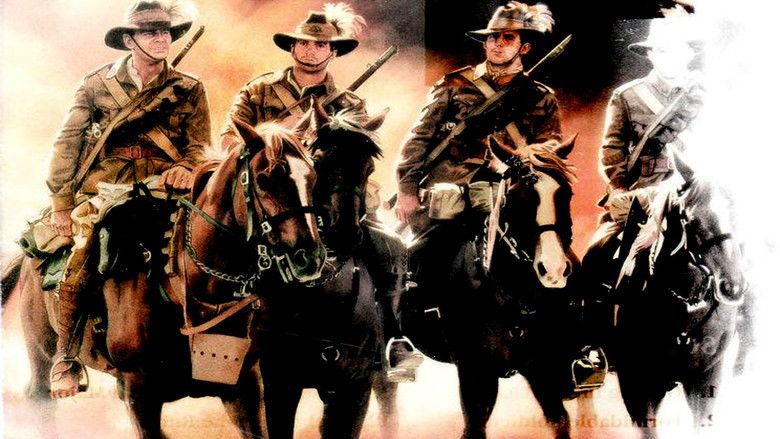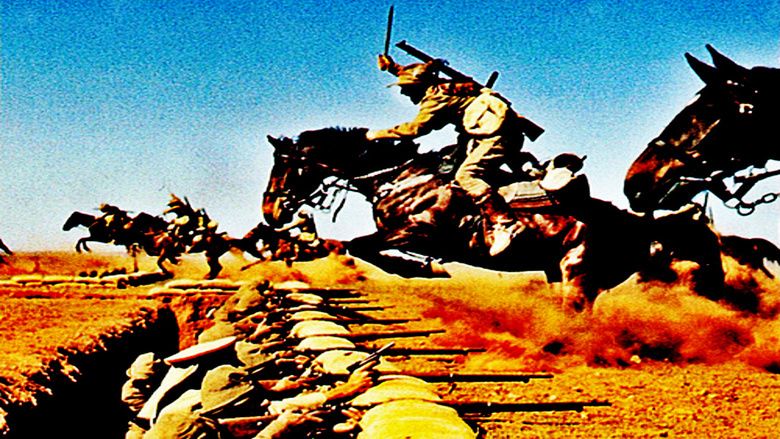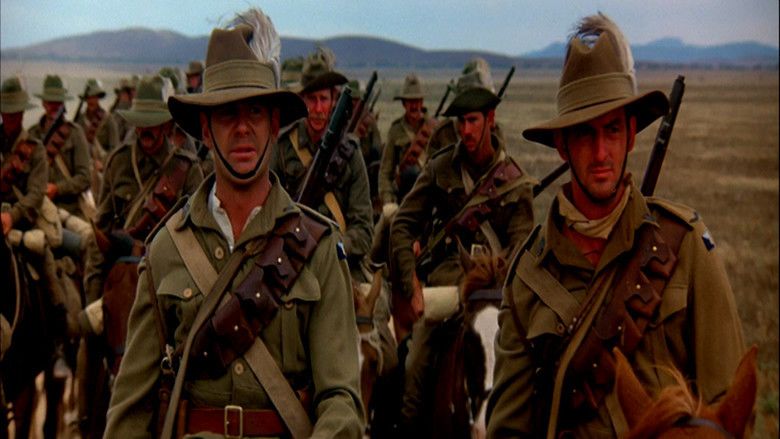The Lighthorsemen (film)
7.2 /10 1 Votes
Duration Country Australia | 7/10 IMDb Genre War, Drama Writer Ian Jones Language English | |||||||||||||||||||||||||||||||||
 | ||||||||||||||||||||||||||||||||||
Release date 10 September 1987 (1987-09-10) (Australia)8 April 1988 (1988-04-08) (United States) Cast (Dave Mitchell), Nick Waters (Lighthorse Sargeant), John Larking (Stationmaster), John Haywood (Dave's Dad), Di O'Connor (Dave's Mum), (Reichert)Similar movies Tagline They did what they were told... They didn't know it was impossible! | ||||||||||||||||||||||||||||||||||
The lighthorsemen opening
The Lighthorsemen is a 1987 Australian feature film about the men of a World War I light horse unit involved in Sinai and Palestine Campaign's 1917 Battle of Beersheeba. The film is based on a true story and most of the characters in the film were based on real people. (Elyne Mitchell wrote the novelization based on the screenplay.)
Contents
- The lighthorsemen opening
- The lighthorsemen charge at beersheba
- Plot
- Production
- Historical inaccuracies
- Reception
- The lighthorsemen battle of gaza
- The lighthorsemen 1987 australian 4th light horse charge
- References

It follows in the wake of other Australian New Wave war films such as Breaker Morant (1980), Gallipoli (1981), and the 5-part TV series Anzacs (1985). Recurring themes of these films include the Australian identity, such as mateship and larrikinism, the loss of innocence in war, and also the continued coming of age of the Australian nation and its soldiers (the ANZAC spirit).

The lighthorsemen charge at beersheba
Plot

The film follows Four Australians (Frank, Scotty, Chiller, and Tas) in Palestine in 1917, part of the 4th Light Horse Brigade of the British and Commonwealth Dominion forces. When Frank is wounded and dies of his wounds, he is replaced by Dave. Dave finds himself unable to fire his weapon in combat and is transferred to the Medical Corps, where he will not need to carry a weapon, but where he will still be exposed to the fighting.

The British plan the capture of Beersheba. During an attack by Turkish cavalry, Major Richard Meinertzhagen deliberately leaves behind documents indicating that the attack on Beersheba will only be a diversion. The Australians leave for Beersheba, with limited water and supplies. They bombard the town and the 4,000 Turkish-German defenders prepare for an assault. However, the German military advisor, Reichert, believes it is a diversionary attack and advises the Turkish commander he does not need reinforcements. With time running out and water in short supply, the British command suspect any attack upon Beersheba will probably fail. However, the Australian commanders ask the British to send in the Australian Light Horse—the British consent to what they think is a suicide mission.

On 31 October, the 4th and 12th Light Horse Regiments are ordered to attack. Dave and the rest of the medical detachment prepare for casualties and are ordered in behind the Light Horse. The Turks report the Australian mounted soldiers lining up to charge, however the officer in charge orders the Turks not to open fire until they dismount. The Australians begin advancing on the Turkish positions, gradually speeding up to a charge. The Turks realise too late that the soldiers are not dismounting and open fire. Artillery fire is sporadic and of limited effect and the attack so fast the Turkish infantry forget to adjust the sights on their rifles as the Light Horse get closer, eventually firing straight over the Australians' heads.
During the charge, Tas is killed by an artillery shell. The remaining Australians make it "under the guns" (advancing faster than the artillery can correct its aim for the reduced range) and reach the Turkish trenches. Field Artillery has a Minimum Range and when the call was made that they were "Under The Guns", it meant that the gunners could not depress their guns any lower meaning thatany subsequent shells would land behind the charging Lighthorsemen instead of before or in the middle of them. The Australians capture the first Turkish defences. Scotty and a few others take control of the guns. Chiller is wounded in the trench fight. Dave is struck by a grenade and is seriously wounded while protecting Chiller. Scotty continues to fight on into the town. When most of the remaining Turks surrender, Reichert tries to destroy the wells, but is captured by Scotty. Overall, the attack was a success and the Australians miraculously suffered only 31 dead and 36 wounded. This effectively opened the 'door' and allowed for the subsequent capture of Jerusalem and the rest of the country.General Allenby, in deference to the Holy City, walked into the city, coming as a Liberator not a conqueror.
Production
The script was written by Ian Jones, who had long been interested in the Australian Light Horse ever since they featured in an episode of Matlock Police in 1971. He visited Beersheba in 1979 and had carefully researched the period. Simon Wincer came on board as director and he succeeded in helping secure a $6 million pre sale to RKO. Antony I. Ginnane's Film and General Holdings Company succeeded in raising the rest of the money. Simon Wincer later claimed that Ginanne, Ian Jones and himself had to put in their own money at some stage when the film looked like falling over. Well known Australian cinematographer Dean Semler was also brought in.
Despite being set in Palestine and Egypt, the film was shot entirely on location in Victoria and Hawker, South Australia. After the final day of filming had wrapped on 1 December 1986, actor Jon Blake was injured in a car accident near Nectar Brook, South Australia. He suffered permanent paralysis and brain damage.
The musical score was composed by Mario Millo. The original soundtrack recording was produced for compact disc release courtesy of Antony I Ginnane by Philip Powers and Mario Millo for Australian distribution in Australia by 1M1 Records and as a coupling with Shame on LP in the US. The movie was re-cut to a shorter length for the US release, which Wincer thought made the second half better, although he did not like the opening as much.
Historical inaccuracies
The German Empire flag on General Kressenstein's car features a band of red above a band of white, above a band of black; in reality, the colours were ordered black-white-red. Similarly, the Australian flag – known at the time as the "Australian Blue Ensign" – was not widely used by the Australian Army during World War I. The British Union flag was more widely used by the military, while government regulations and tradition meant the Blue Ensign was used mainly by government buildings and ships.
Reception
The film received positive to mixed views from critics. Rotten Tomatoes gives it an 80% approval rating, based on five reviews. Roger Ebert, reflecting other critic's opinions, stated that "I was disoriented almost all the way through the movie." but that in the climax, "I haven't seen a better action scene with horses since “Ben Hur.”" An unfavourable review came from The New York Times, who stated the film was "a sort of pacifist-aggressive war adventure" and that "None of the performances are really bad, but none are very good". The Washington Post also gave the film a negative review, described it as "Mostly ... equine cinematography, a four-legged coffeetable movie about the Australian cavalry.".
The film grossed A$1,617,288 in Australia after its release in 1987which is equivalent to 8.25 million in 2009 dollars. It was also released in Canada, Sweden, the United Kingdom, and the United States in 1988. It was considered a commercial disappointment, yet Wincer claims its pre-sales and television sales were about $6 million or 60% of the budget. The film won an AFI award in 1988 for Best Original Music Score and another for Best Achievement in Sound. It was also nominated for Best Achievement in Cinematography. The Lighthorsemen is included in the Australian Film Commission's Top Australian films at the Australian box office list at number 83.
The lighthorsemen battle of gaza
The lighthorsemen 1987 australian 4th light horse charge
References
The Lighthorsemen (film) WikipediaThe Lighthorsemen (film) IMDb The Lighthorsemen (film) themoviedb.org
